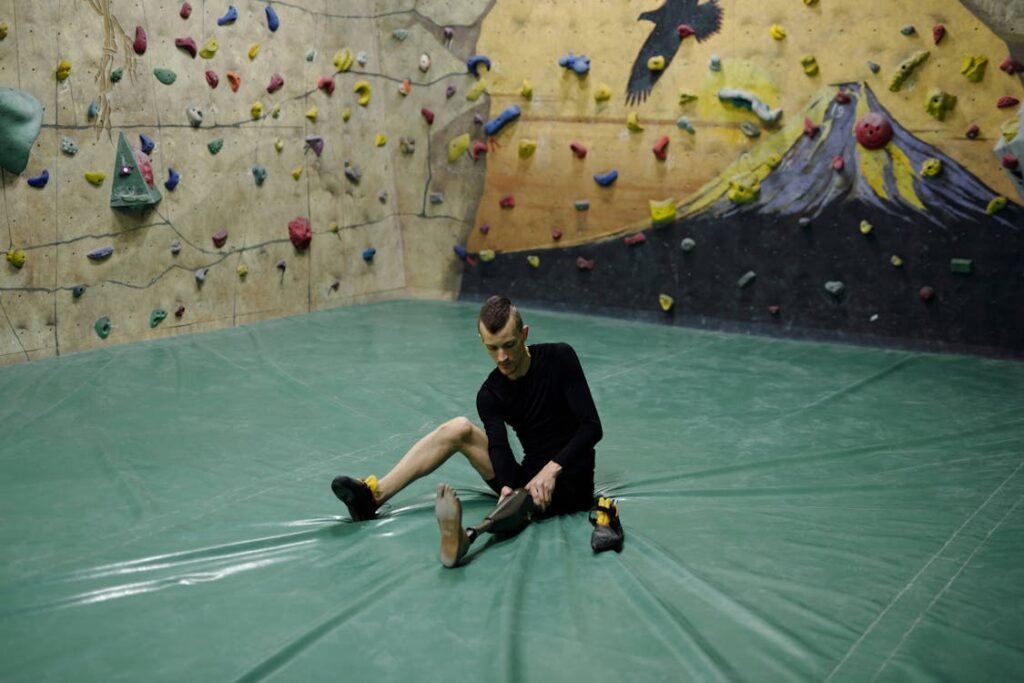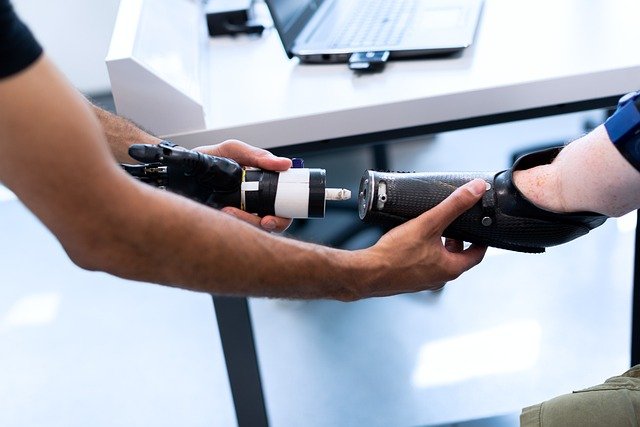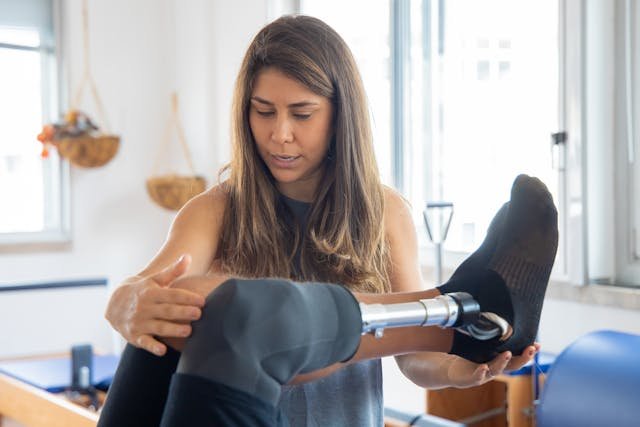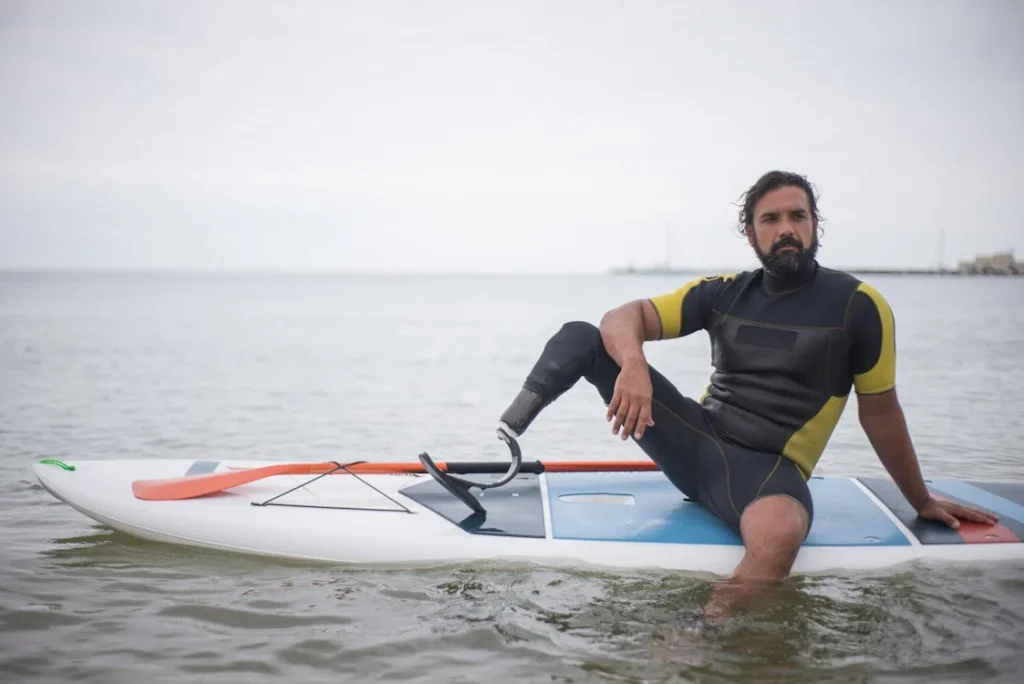Staying active with a sports prosthetic limb is an incredible achievement. Whether you’re running, cycling, swimming, or engaging in any other sport, your prosthetic limb helps you push your limits. But just like any high-performance equipment, it requires proper care to function at its best.
Without regular maintenance, your prosthetic limb may wear out faster, affecting your comfort, performance, and even safety. Dirt, sweat, and everyday use can take a toll, making it essential to follow a proper cleaning and maintenance routine. The good news? Taking care of your sports prosthetic limb is not complicated. With simple steps, you can keep it in top shape, ensuring it lasts longer and performs optimally.

Daily Cleaning and Hygiene for Your Sports Prosthetic Limb
Taking care of your sports prosthetic limb starts with daily cleaning. Since sports involve intense physical activity, sweat and dirt can quickly build up on your prosthetic, leading to discomfort, skin irritation, and even unpleasant odors.
To prevent this, cleaning should be a part of your daily routine, just like brushing your teeth or taking a shower.
Keeping the Socket Clean and Fresh
The socket is the part of your prosthetic limb that makes direct contact with your skin. It absorbs sweat and bacteria throughout the day, which, if left uncleaned, can lead to rashes, infections, or bad smells.
Cleaning the socket at the end of each day is essential. Use a mild, non-alcoholic soap with warm water to wipe down the inner surface. A soft, damp cloth works well to remove any residue or sweat buildup.
Make sure you let the socket air dry completely before putting it back on, as moisture trapped inside can cause skin issues.
For those who sweat excessively, using a clean, dry cloth to wipe down the socket during breaks in training or practice sessions can help prevent excessive moisture buildup.
Some athletes also use special antibacterial wipes designed for prosthetic care, which can be a quick and easy way to maintain hygiene throughout the day.
Cleaning the Prosthetic Liner
The liner of your prosthetic limb plays a key role in comfort and fit. Since it absorbs a lot of sweat and pressure during activities, it needs extra attention.
Washing the liner daily with mild soap and lukewarm water will help remove sweat, dirt, and bacteria. Rinse thoroughly to ensure no soap residue remains, as leftover soap can irritate your skin.
After washing, let the liner air dry in a well-ventilated area. Avoid placing it near direct heat sources like radiators or dryers, as excessive heat can damage the material.
If you have an extra liner, rotating between them can extend their lifespan and ensure you always have a clean one ready to use.
Caring for the Foot or Hand Attachment
If your sports prosthetic limb includes a foot or hand attachment, it’s important to check for dirt, dust, or mud after every session. Depending on your activity, different terrains or environments can cause debris to get lodged in the joints or moving parts.
Wiping down these components with a damp cloth after each use can prevent long-term damage.
For prosthetic feet designed for running or cycling, make sure to inspect the tread for wear and tear. Just like the soles of a shoe, these parts can wear out over time and may need replacement to maintain proper grip and functionality.
Keeping an eye on these details ensures that your prosthetic performs at its best during every workout.
Managing Sweat and Odor
Sweat is a natural part of sports and physical activity, but when it comes to prosthetics, it can create discomfort if not managed properly. Some athletes find that using a prosthetic-friendly antiperspirant helps reduce excessive sweating in the socket area.
However, it’s important to avoid products with harsh chemicals that could cause skin irritation.
Wearing a clean prosthetic sock or sleeve can also help absorb moisture and provide extra comfort. These accessories can be washed regularly and swapped out when needed, keeping your limb dry and fresh.
Inspecting for Damage and Wear
Daily maintenance isn’t just about cleaning—it’s also about checking for signs of wear and tear. Small issues like loose screws, tiny cracks, or worn-out straps can quickly become bigger problems if left unattended.
A quick inspection before and after every training session can help you catch these issues early. If you notice anything unusual, contact your prosthetist for advice.
Regular maintenance checks can save you from unexpected breakdowns and keep your prosthetic limb in top condition.

Weekly and Monthly Maintenance for Long-Term Performance
While daily cleaning keeps your sports prosthetic limb fresh and hygienic, regular deep maintenance ensures its longevity and peak performance.
Sports prosthetics endure significant strain, especially in high-impact activities like running, jumping, or weightlifting. Without proper upkeep, minor wear can escalate into major damage. A dedicated weekly and monthly care routine will help you get the most out of your prosthetic.
Deep Cleaning the Components
Beyond wiping down the socket and liner daily, a more thorough cleaning should be done at least once a week. Sweat and dirt can accumulate in areas that are harder to reach, such as small crevices or under protective covers.
Using a soft brush and mild soap, gently clean these areas to remove any hidden buildup. If your prosthetic has mechanical joints or hinges, check for any grime that may affect movement.
After cleaning, allow all parts to dry completely before reassembling to avoid moisture damage.
For water-resistant prosthetics used in swimming or water sports, it’s crucial to rinse them with fresh water after every session. Chlorine from pools and salt from seawater can be corrosive over time.
A more detailed cleaning with fresh water and a gentle soap should be part of your weekly routine to prevent material degradation.
Checking for Loose Screws and Moving Parts
Prosthetic limbs, especially those designed for sports, experience a lot of impact. Over time, screws, bolts, and joints may become loose. A quick weekly inspection can help prevent unexpected failures.
Carefully check all fasteners and tighten anything that feels loose. If you notice excessive movement in any part, it might need professional attention.
For athletes who engage in intense activities, it’s a good idea to visit your prosthetist for an adjustment every few months. Small tweaks can enhance comfort and performance, preventing discomfort or potential injuries caused by misalignment.
Evaluating the Suspension System
The suspension system, which keeps the prosthetic securely attached to your limb, plays a vital role in comfort and performance. If you use a vacuum or pin-lock system, make sure the seals and locking mechanisms are functioning properly.
Any minor malfunction in these systems can lead to instability, affecting your ability to move efficiently.
If you use sleeves or straps for suspension, check for any signs of wear. Cracks, stretching, or fraying are indicators that they may need replacement.
A worn-out suspension system can affect how your prosthetic fits, leading to discomfort or even skin irritation. Replacing these parts before they fully wear out ensures a secure and reliable fit.
Lubricating Moving Parts
Some sports prosthetics come with mechanical joints that need occasional lubrication to keep them moving smoothly. If your prosthetic includes hinges or rotating parts, applying a small amount of prosthetic-approved lubricant can prevent stiffness and squeaking.
However, it’s important to use only recommended lubricants—using the wrong kind may cause long-term damage.
Assessing the Fit and Comfort
Over time, changes in your body can affect how your prosthetic fits. Weight fluctuations, muscle growth, or changes in your residual limb shape can make the socket feel tighter or looser.
If you notice increased pressure points, rubbing, or discomfort, it might be time for a fit adjustment.
If your prosthetic feels off balance or you find yourself compensating with unnatural movements, a realignment may be necessary. Even small misalignments can lead to discomfort or muscle strain.
Regularly assessing your comfort ensures that your prosthetic continues to support your movements naturally.
Testing Performance in Different Conditions
Athletes often train in various environments, from smooth running tracks to rough trails. It’s a good practice to test your prosthetic in different conditions to identify any potential issues.
For instance, if you notice a decrease in grip on wet surfaces, it might be time to replace or upgrade the tread on your prosthetic foot.
If you participate in multiple sports, consider having different attachments suited for each activity. Some sports prosthetics are designed specifically for running, cycling, or swimming.
Ensuring that you have the right components for your sport can improve your performance and prevent unnecessary strain on your prosthetic.
Planning for Professional Check-Ups
While personal maintenance is essential, professional servicing is just as important. Scheduling a check-up with your prosthetist every few months ensures that your prosthetic is in optimal condition.
Prosthetists can detect issues that might not be visible to you and make necessary adjustments to enhance comfort and functionality.
During these visits, you can also discuss any discomfort, performance concerns, or upgrade options. If you notice any unusual noises, increased friction, or reduced performance, it’s best to have your prosthetist examine the limb before the issue worsens.

Handling Repairs and Replacements for Your Sports Prosthetic Limb
Even with the best care, your sports prosthetic limb will eventually require repairs or replacements. High-intensity activities put stress on the components, and over time, materials can wear down.
Addressing issues early prevents small problems from turning into major failures that could disrupt your training or competition. Knowing when to repair and when to replace parts will help you maintain peak performance and safety.
Identifying Early Signs of Wear and Damage
The first step in managing repairs is recognizing when something isn’t right. If you start experiencing discomfort, hear unusual noises, or notice changes in how your prosthetic limb moves, it’s time for an inspection.
Common signs of wear include cracks in the socket, loosened joints, or decreased flexibility in moving parts. Even subtle shifts in fit or alignment can signal that something needs attention.
For prosthetic feet or running blades, check for excessive wear on the tread. A worn-down surface can reduce traction, increasing your risk of slipping or losing stability.
If your prosthetic limb has a suspension system, test whether it still provides a snug and secure fit. Any looseness or instability could mean the suspension needs to be adjusted or replaced.
When to Repair vs. When to Replace
Minor repairs, such as tightening screws, replacing liners, or adjusting straps, can usually be done at home or with a quick visit to your prosthetist.
However, if a critical component is damaged—like the socket, knee joint, or mechanical foot—it’s best to replace it rather than risk performance failure.
If you feel discomfort that wasn’t there before, your socket may no longer fit correctly. Over time, changes in your residual limb’s shape can make the fit less secure. In such cases, a socket replacement or adjustment is necessary to restore comfort and stability.
For advanced prosthetics with electronic components, any issues with sensors, motors, or connectivity should be addressed by a professional. Attempting to fix these parts without proper knowledge can cause more harm than good.
Emergency Fixes to Keep You Going
Sometimes, issues arise at inconvenient times—right before a competition or in the middle of an intense training session. While professional repairs are always the best solution, knowing how to manage minor emergencies can help you stay active until you can see a specialist.
Carrying a small maintenance kit with a few essentials like a screwdriver, spare straps, and a cleaning cloth can be a lifesaver.
If a screw comes loose, you can tighten it temporarily until you get professional help. If your liner is causing discomfort, switching to a backup liner can provide relief.
In cases where a sudden breakage occurs, avoid using makeshift fixes that could put stress on other parts of your prosthetic. Instead, stop using the limb and seek professional assistance as soon as possible.
Continuing to use a damaged prosthetic can lead to further damage or even injury.
Upgrading Your Prosthetic for Better Performance
Technology in sports prosthetics is constantly evolving. If your current limb is no longer meeting your needs, upgrading to a newer model or a more sport-specific attachment could improve your performance and comfort.
Advancements in materials and design mean that modern prosthetics are lighter, stronger, and more responsive than older models.
If you notice limitations in your current limb—such as reduced flexibility, lack of shock absorption, or difficulty keeping up with your sport—it may be time to explore new options.
Consulting with your prosthetist about the latest innovations can help you decide if an upgrade would benefit you.

Protecting Your Prosthetic Limb from Environmental Damage
Your sports prosthetic limb is built for durability, but exposure to different environmental conditions can impact its performance and lifespan.
Whether you’re training in the rain, running on sandy trails, or cycling under the scorching sun, external elements can wear down your prosthetic over time.
Knowing how to protect your limb from environmental damage ensures it stays in top condition, no matter where you train or compete.
Dealing with Water and Moisture
Not all prosthetic limbs are waterproof, and even those that are water-resistant need proper care after exposure to moisture. If you train in wet conditions or participate in water sports, always check whether your prosthetic is designed to handle prolonged exposure to water.
For non-waterproof prosthetics, it’s crucial to keep them dry at all times. If your limb gets wet due to rain or sweat, wipe it down immediately with a dry cloth.
Moisture trapped in the socket or joints can lead to rust, corrosion, or bacterial buildup, which can weaken the materials and cause skin irritation.
For waterproof prosthetics, rinsing with fresh water after exposure to saltwater or chlorine is essential. Salt can cause corrosion, while chlorine can degrade certain materials over time.
After cleaning, ensure all parts are completely dry before reassembling the prosthetic. If your limb has mechanical joints, applying a light prosthetic-safe lubricant after drying can help prevent stiffness.
Protecting Against Dust and Dirt
Athletes who train in outdoor environments, such as trails, fields, or beaches, often deal with dust, dirt, and sand. These tiny particles can accumulate in the moving parts of your prosthetic, leading to friction, stiffness, or even mechanical failure.
Regularly wiping down your prosthetic with a damp cloth can prevent buildup, but deeper cleaning is necessary if you frequently train in dusty conditions.
For prosthetics with joints or hinges, checking for trapped dirt and removing it with a soft brush or compressed air can prevent long-term damage.
If you use a running blade or foot designed for rough terrains, inspecting the grip and removing lodged debris will help maintain traction and stability.
Handling Extreme Heat and Cold
Extreme temperatures can impact the materials in your prosthetic limb. Excessive heat can soften or warp certain plastics, while cold temperatures can make materials brittle, increasing the risk of cracks or breakage.
If you train in hot weather, avoid leaving your prosthetic limb in direct sunlight or inside a parked car for extended periods. Heat exposure can weaken adhesives, affect the fit of your socket, and degrade rubber or silicone components.
Storing your prosthetic in a shaded, cool area when not in use helps prevent unnecessary wear.
In cold weather, materials like carbon fiber and titanium handle low temperatures well, but liners, straps, and seals may become stiff. If your prosthetic feels rigid or uncomfortable in the cold, warming it up gradually indoors before use can improve comfort.
Wearing thermal prosthetic socks can also help maintain warmth and prevent discomfort during training in winter conditions.
Avoiding Chemical Exposure
Certain chemicals, such as cleaning agents, oils, and solvents, can degrade the materials in your prosthetic.
If you train in an environment where chemicals are present—such as a gym that uses heavy disinfectants—make sure your prosthetic doesn’t come into direct contact with harsh substances.
Using only recommended cleaning products designed for prosthetics ensures that your limb remains in good condition. If your prosthetic accidentally comes into contact with a strong chemical, rinse it with water immediately and inspect for any signs of damage.

Maintaining Skin Health While Using a Sports Prosthetic Limb
Caring for your sports prosthetic limb isn’t just about keeping the device in good shape—it’s also about taking care of your skin. The connection between your residual limb and the prosthetic plays a crucial role in comfort and performance.
Without proper skin care, irritation, blisters, and infections can develop, making it difficult to train or compete effectively.
Preventing Skin Irritation and Pressure Sores
The friction between your skin and the prosthetic socket can cause redness, soreness, and even painful blisters. Sweating during sports increases the chances of irritation, especially if moisture gets trapped inside the socket.
To reduce friction, keep your skin clean and dry before wearing your prosthetic. Washing your residual limb with mild soap and water at least twice a day can help remove bacteria and prevent infections.
Wearing a well-fitted liner or prosthetic sock can also minimize rubbing. If you notice red spots or sore areas after wearing your prosthetic, it may indicate that the socket isn’t fitting properly.
Over time, pressure points can lead to deeper sores if not addressed. If discomfort persists, visiting your prosthetist for an adjustment is crucial. A minor modification to the fit can prevent long-term skin issues.
Managing Excessive Sweating
Sweating is a natural response to intense physical activity, but when it happens inside the socket, it can cause discomfort and odor. Excess moisture also makes it easier for bacteria to grow, leading to rashes or fungal infections.
Using a prosthetic-friendly antiperspirant before putting on your limb can help manage sweat levels. However, avoid using regular deodorants or powders, as they can leave residues that irritate the skin or damage the liner.
Changing your liner or prosthetic sock regularly is another way to keep moisture under control. Some athletes prefer using moisture-wicking liners that draw sweat away from the skin, reducing the chances of irritation.
If you sweat excessively, taking short breaks during training to wipe down your limb and socket can keep things dry and comfortable.
Checking for Skin Breakdowns and Infections
Daily skin inspections are a must for athletes using prosthetic limbs. Small cuts, blisters, or irritations can quickly turn into bigger problems if left untreated.
Pay close attention to any areas where the prosthetic applies the most pressure. If you notice persistent redness that doesn’t fade after removing the limb, it may indicate excessive pressure that needs to be addressed.
If you develop an open wound, avoid wearing your prosthetic until it has healed completely. Wearing a prosthetic over broken skin can slow down healing and increase the risk of infection.
Applying a protective bandage and keeping the area clean can speed up recovery. If the wound worsens or shows signs of infection—such as swelling, warmth, or discharge—seeking medical attention is important.
Adapting to Seasonal Changes
Your skin reacts differently to different weather conditions, and this can affect how your prosthetic fits and feels. In hot weather, sweating increases, which may require extra care to prevent irritation.
In colder months, dry skin can lead to cracking, making it more prone to discomfort or sores. Using a light, unscented moisturizer before bed can keep your skin hydrated without making it greasy during the day.
Some athletes also experience changes in the size of their residual limb due to temperature shifts. If your prosthetic feels tighter or looser than usual, adjusting the number of prosthetic socks you wear or consulting your prosthetist for a slight modification can help.
Building a Healthy Skin Care Routine
Establishing a skin care routine that works for your lifestyle and activity level will help you stay comfortable in your prosthetic.
Simple habits like cleaning your residual limb daily, keeping your liner and socket free of moisture, and checking for skin issues can prevent discomfort and allow you to focus on your sport.
By taking care of both your prosthetic limb and your skin, you’ll not only extend the life of your device but also improve your overall experience in training and competition.
Comfort and performance go hand in hand, and a well-maintained prosthetic limb combined with healthy skin will help you stay at your best.

Conclusion
Caring for your sports prosthetic limb is an ongoing process that ensures durability, comfort, and optimal performance. Daily cleaning, regular maintenance, and professional check-ups help prevent wear and tear, while protecting it from environmental damage extends its lifespan. At the same time, prioritizing skin health reduces irritation and discomfort, allowing you to stay focused on your sport.
Small issues, like loose screws or excessive sweating, can escalate if ignored. Staying proactive with repairs and adjustments ensures your prosthetic functions smoothly when you need it most. If discomfort or performance concerns arise, consulting your prosthetist promptly can prevent long-term complications.
Your prosthetic limb is more than just a tool—it’s a part of your athletic journey. By maintaining it properly, you not only extend its life but also enhance your own performance and confidence. Whether you’re training, competing, or simply staying active, a well-maintained prosthetic will support you every step of the way.
Need professional guidance or a check-up for your prosthetic? Contact Robobionics today for expert support and personalized solutions!



